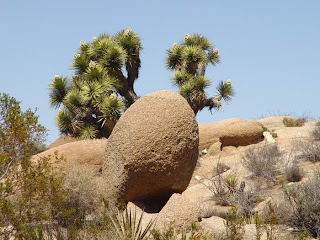


The short route thru Joshua Tree National Park in California is 47 miles. We were disappointed for the first half of those miles as traveled from the south entrance. All we saw was the same terrain of scattered pebbles on low mountains that we saw from endless miles along Interstate 10. The only vegetation was creosote bushes.
The only item of interest to Terry, in the first half of the miles we traveled, was the solar power that a worker said was the only power source in the park. Solar power ran the visitors centers, entrance stations and residences for the employees of the park. He said that the park had 194 solar panels.
When we arrived at the Ocotillo Patch we saw that the stick like bushes had red blooms!
Next we were seeing cholla, yucca and prickly pear cacti in bloom. In the distance, we viewed large rounded boulders. At last we saw the Joshua trees. An exhibit sign in the park said “the blossoms of the Joshua tree are pollinated only by the yucca moth.” The lack of plants, especially the yucca, was the reason that we had not seen Joshua trees.
The roads are good paved roads with good exhibit areas and nine campgrounds. The only problem was that the campgrounds had very small sites. Although you may get a large RV in some sites, they were not wide enough to put a slide out.
An Rver spoke to me as I was taking pictures. He told me that the park had a blanket of snow two days earlier on March 27, 2005 at three to four thousand feet in altitude. As I left, I asked him, “ What planet are we on?” He said, “I do not know.”
The scenery to me looked like some giant children had played in the mud and made objects that were familiar to them such as balls, stacked pancakes, and eggs. Some of these rounded objects had broken during the years the playground was abandoned.
The next day Terry happened to watch Star Trek Voyager on television. It was a happy surprise to see that many scenes looked like they were shot from the Joshua Tree National Park location.
The only item of interest to Terry, in the first half of the miles we traveled, was the solar power that a worker said was the only power source in the park. Solar power ran the visitors centers, entrance stations and residences for the employees of the park. He said that the park had 194 solar panels.
When we arrived at the Ocotillo Patch we saw that the stick like bushes had red blooms!
Next we were seeing cholla, yucca and prickly pear cacti in bloom. In the distance, we viewed large rounded boulders. At last we saw the Joshua trees. An exhibit sign in the park said “the blossoms of the Joshua tree are pollinated only by the yucca moth.” The lack of plants, especially the yucca, was the reason that we had not seen Joshua trees.
The roads are good paved roads with good exhibit areas and nine campgrounds. The only problem was that the campgrounds had very small sites. Although you may get a large RV in some sites, they were not wide enough to put a slide out.
An Rver spoke to me as I was taking pictures. He told me that the park had a blanket of snow two days earlier on March 27, 2005 at three to four thousand feet in altitude. As I left, I asked him, “ What planet are we on?” He said, “I do not know.”
The scenery to me looked like some giant children had played in the mud and made objects that were familiar to them such as balls, stacked pancakes, and eggs. Some of these rounded objects had broken during the years the playground was abandoned.
The next day Terry happened to watch Star Trek Voyager on television. It was a happy surprise to see that many scenes looked like they were shot from the Joshua Tree National Park location.
1 comment:
I love the new look of your blog. Hope you keep us posted on your travels.
Post a Comment